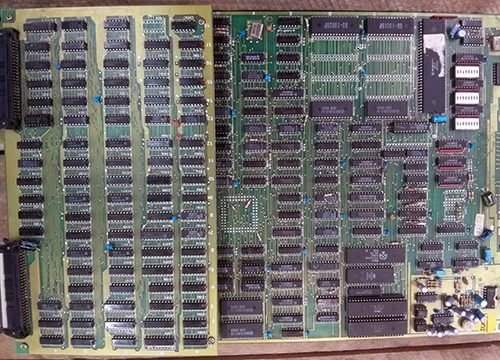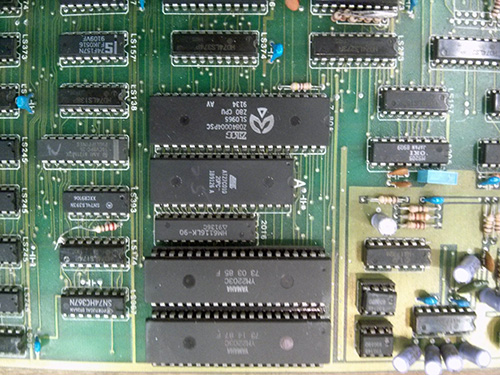The Ware for July 2015 is shown below:
Ahh…hardware from the 80’s/early 90’s. My favorite era, when circuit board traces were laid out freehand using pen or tape and 74-series logic gates were still a thing. Thanks to Felipe Sanches for providing the ware, and to xobs for taking the photos while he was in Brazil for his keynote at FISL16!
Sorry for the lack of updates on this blog, it’s been a busy summer. To get a whiff of what I’ve been up to, check out my article in Wired Magazine on trends enabling the decentralization of innovation in hardware and Jinjoo’s blog-in-progress on the manufacturing bootcamp I held this summer in Shenzhen for MIT Media Lab students, which also happened to be the inaugural application of our new Orchard IoT Platform.


The 68000/Z80 combination is strongly reminiscent of Sega game systems like the Mega Drive, but this assembly is much too large to be a home console which leads me to believe it’s an arcade system of some sort.
There are a number of machines using that coprocessor configuration in the System 16 line. I can’t positively identify this as any one of them, but they can be narrowed down some with the dual YM2203s. Space Harrier is pretty close with the same dual-board construction and ribbon cable interconnect: http://system16.com/hardware.php?id=696
Most of the chips are dated mid/late 1991, were they still making that board that late?
Probably not that particular game, but I’m not enough of an arcade expert to know how long production on a given machine might run. There aren’t any photos of the boards that I’ve seen, but it could very well be F-1 Dream or Last Duel, both of which fit the general profile (a 68k, Z80 and two YM2203) and are a little bit newer.
Without a doubt an arcade board, but almost certainly a bootlegged one – very few decoupling capacitors, almost completely built from 74 logic and a few PALs/GALs even though it appears to be from the early ’90s and resistor arrays bodged together from discrete resistors are usually good indicators for that. You purposefully clipped away almost all of the edge connector, but it looks like it doesn’t have the usual notch at pin 7 which is also a common “feature” of bootlegged boards.
Guessing the specific game just from the pictures will likely be hard though, 68k plus Z80 is a really common combination. The small part that is still visible of the edge connector seems to suggest that it has a JAMMA pinout with -5V not used, so I wouldn’t zero in on System 16 just yet – although there are probably System 16-bootlegs with JAMMA pinout.
Oh, and there is one more detail that could be useful to identify the actual game: There seem to be two OKI M5205 ADPCM-DACs just right of the Z80.
After browsing the MAME sources a bit, there seems to be one game that mostly fits the known data: Final Crash, a bootleg of Final Fight. It’s not an exact match though, because in the MAME sources it is set up to use 8 ROMs with 128k each for the program data, but there are only two ROMs next to the CPU in the pictures. Since there are no sockets and the pads are filled with solder it is unlikely that and ROMs were removed. Still, it is a possible match because 512k (EP)ROMs in the same 32-pin DIP package exist and the manufacturer may have decided to use the larger chips for cost/availability reasons. The two additional address pins (30 and 31) seem to be connected on the unpopulated ROM spaces and based on their trace width they do not seem to be hardwired to either VCC or GND, so I would guess that the board can be (is) prepared for 512k program ROMs.
That guess is still rather uncertain though, MAME doesn’t emulate everything and just because a bootleg uses some particular sound chips it doesn’t mean that the original uses the same ones. For identification purposes it would be much easier to power up the board or read out the ROMs (if proper desoldering equipment is available). =)
It’s a Carrier Air Wings bootleg, there’s a picture here:
http://arcade-system.actifforum.com/t3026-capcom#179626
Identifying it was actually pretty easy. I checked MAME’s database for boards with a 10MHz 68000, a Z80, two YM2203s and two 5205s and it turns out there were only a couple that fit that description. Two Google Image searches later I found it.
Can confirm, it is most likely Carrier Air Wings CPS-1 bootleg board, but, very very similar bootleg boards have been seen in some other games, e.g. Final Fight. I think it may have been more generic board, that manufacturer used with slight alterations and different roms. Funny how there was arcade piracy, as it was not so easy as just copying cassette or floppy disc. After CPS-1 Capcom went crazy with copy protection, and encrypted arcade roms with key that was held in memory by backup battery. If battery went flat… Well that copy protection were problem for legitimate owners.
You have to go back to the ’70s to find hand drawn PCBs; CAD was definitely a thing for creating PCBs in the 1980s. The exception would be smaller shops (or smaller designs).
I wonder how routing was done then using CAD? If I look at the traces on this board, they are unevenly spaced, and the mitering on the corners look like they are rounded by hand. I suppose CAD programs in the 80’s probably had more in common with MS Paint than the tools I’m used to using today :)
well not quite – they made photoplotter output (what gerbers evolve from) rather than pixels
Hi Bunnie,
I’m writing to you from MM ONE Group, a renowned Italian Digital Agency. Now we are collaborating with Seco srl, an italian business specialized in designing and manufacturing microcontroller.
We are getting in touch with you to kindly offer you the opportunity to collaborate with our Web Agency allowing us to publish into your blog, with rate, a file in pdf format in which our client’s product is mentioned.
I look forward to hearing from you and don’t hesitate to contact me via email (meiling.ou@mm-one.com) for any further information or questions.
Regards,
MM ONE® GROUP
Meiling Ou
Social Media Specialist and Digital Pr
Tel. +39 0421 65261
Fax +39 0421 308742-308056
Web http://www.mm-one.com
Unrelated to this thread, I just wanted to drop this link a “Name that ware”-like blog post that I found a while ago:
http://softsolder.com/2015/07/01/monthly-science-mystery-chip/
Maybe someone knows what this is
Well I’m guessing it’s a Yamaha synth of some kind. Could be a prototype for the DX7 maybe. What are the date codes on the chips? I can’t see from here. If that second board had DRAM I’d have guessed a sampler but it looks from here to just be a mess of discrete logic. So if not the DX7 then maybe one of the predecessors to it, prior to the FM ASICs being developed?
Great, Thanks for information
I was using smartwork pcb design software on the IBM PC in 1987 (using 4000 series CMOS in the design) and later in 1991 with Protel PCB. Tape was used prior to 1985.
Thank you , as our technology grows fast.
Z80B and a pair of YM2203’s along with an OKI M5205 is the sound combination that DATSU used in their bootleg system 16 boards. I know because I’m looking at one right now.
They sound really strange compared to the YM2151 & the Nec uPD7751 combination of the SEGA Sysetm16 board.
You have to go back to the ’70s to find hand drawn PCBs; CAD was definitely a thing for creating PCBs in the 1980s. The exception would be smaller shops.